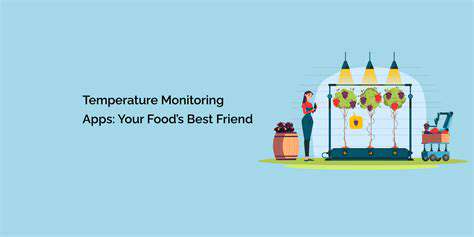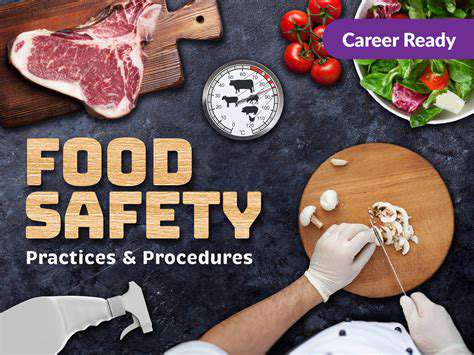Food Safety During Holidays: Keep Your Guests Safe

Maintaining Optimal Temperatures for Food Safety
Maintaining the correct temperature for food storage and preparation is crucial for preventing the growth of harmful bacteria and ensuring food safety. Proper temperature control is a fundamental aspect of food handling and preservation. Failure to adhere to these guidelines can lead to foodborne illnesses, which can range from mild discomfort to severe health complications. Understanding the temperature danger zone is essential for preventing these issues.
Food safety regulations are in place to safeguard public health. These regulations outline specific temperature ranges for different types of food, and adhering to these guidelines is vital for ensuring that food remains safe for consumption. This knowledge is invaluable for both home cooks and professional chefs.
Refrigeration: Keeping Cold Foods Cold
Refrigeration is a critical tool for preserving perishable foods. Storing food at the correct temperature in the refrigerator slows down the growth of bacteria, preventing the development of harmful toxins. Proper refrigeration is paramount for maintaining the quality and safety of food items.
Maintaining a consistent refrigerator temperature is important. Food should not be left out at room temperature for extended periods, as this can increase the risk of bacterial growth. Consider using refrigerator thermometers to ensure your refrigerator is maintaining the optimal temperature.
Freezing: Extending the Shelf Life
Freezing is a valuable method for extending the shelf life of various foods. Proper freezing techniques halt bacterial growth and preserve the quality of the food. The process involves lowering the temperature of food to a point where microbial activity is significantly reduced.
Freezing foods correctly is essential for their safety and quality. This involves properly packaging and freezing the food items to maintain their nutritional value and prevent freezer burn. Freezer burn occurs when food is exposed to air, resulting in the loss of moisture and flavor. This is a common issue when food is inadequately wrapped before being placed in the freezer.
Cooking Temperatures: Destroying Harmful Microorganisms
Cooking food to appropriate temperatures is essential for eliminating harmful bacteria and viruses. This process ensures that the food is safe for consumption, and that it will not cause any potential health issues. The proper cooking temperature varies depending on the type of food being cooked.
Knowing the safe minimum internal temperatures is vital for food safety. For example, poultry should be cooked to a minimum internal temperature of 165°F (74°C) to ensure that harmful bacteria are destroyed. Failure to reach these temperatures can lead to foodborne illnesses.
Thawing Safely: Preventing Bacteria Growth
Thawing food safely is crucial to prevent the growth of harmful bacteria. Thawing food at room temperature can allow bacteria to multiply rapidly, making the food unsafe to eat. Proper thawing methods are necessary for ensuring the safety and quality of thawed foods.
Thawing food in the refrigerator, under cold running water, or using the microwave are safe methods. Avoiding thawing food at room temperature or on the counter is crucial for preventing the risk of foodborne illness. Improper thawing techniques increase the risk of bacterial contamination and potential health problems.
Hot Holding: Maintaining Food Safety During Service
Hot holding is a critical practice for maintaining food safety during service. It prevents the growth of harmful bacteria by keeping food at a temperature that is not conducive to their growth. This practice is essential in restaurants, cafeterias, and other food service settings.
Maintaining the temperature of food at 135°F (57°C) or higher is necessary to prevent the growth of harmful bacteria. Food should be kept at this temperature or higher until it is served to prevent potential foodborne illnesses. Proper hot holding practices are integral to food safety protocols in food service establishments.

Leftovers and Storage: Extending the Festive Feast
Planning Ahead for Leftover Success
Planning for leftovers ahead of time is crucial for maximizing the enjoyment of your holiday feast and minimizing food waste. Consider the types of dishes you'll be preparing and how much each will yield. If you anticipate a significant amount of leftovers, assess your storage capacity to ensure you have enough containers, freezer bags, and airtight wraps to safely store everything. This proactive approach will help you avoid scrambling to find space or solutions once the feast is over.
Don't underestimate the value of portion control when plating dishes. This not only helps with managing leftovers but also ensures everyone enjoys a balanced meal. Knowing how much each person will eat can help you predict and plan for the leftovers, as well as help you avoid over-ordering food, which is a major contributor to food waste. By proactively planning, you can streamline the process and ensure you're ready to enjoy those delicious leftovers.
Safe Storage Techniques for Maximum Shelf Life
Proper storage is paramount to preserving the quality and safety of your holiday leftovers. Use airtight containers or freezer bags to prevent contamination and maintain freshness. For dishes that are best stored in the refrigerator, be mindful of the two-hour rule for hot foods—they should be refrigerated within two hours of being removed from the heat source.
Frozen leftovers should be stored in airtight containers or freezer bags, ensuring they are labeled and dated for easy identification and tracking. Properly storing your leftovers ensures they remain safe to eat and maintain their flavour and texture, allowing you to savor the flavors of your holiday meals for days to come.
The Importance of Temperature Control
Maintaining the correct temperature for your leftovers is crucial for preventing the growth of harmful bacteria. Refrigerate perishable foods promptly, and avoid leaving them at room temperature for extended periods. Using a food thermometer can help you accurately determine if your leftovers are within a safe temperature range.
Freezing Leftovers for Future Enjoyment
Freezing leftovers is a fantastic way to extend the life of your holiday feast. Portion leftovers into freezer-safe containers or bags, ensuring they're properly labeled and dated for easy identification. Freezing allows you to enjoy your holiday meals again without compromising safety or quality. This is a great way to avoid waste and savor the flavors of the holidays well into the new year.
Thawing Leftovers Safely
When thawing frozen leftovers, always use a safe method. Thawing in the refrigerator is the safest option, allowing your food to gradually return to a safe temperature. Never thaw food on the counter at room temperature, as this can lead to bacterial growth.
Thawing leftovers in the microwave is a quick method, but it's important to monitor the food closely to ensure it thaws evenly and doesn't become potentially unsafe. Using a microwave-safe dish and checking the food temperature regularly is crucial.
Labeling and Dating for Easy Identification
Properly labeling and dating your leftovers is essential for maintaining food safety and ensuring you consume them within the recommended timeframe. Clearly label each container with the date it was prepared and the contents, and mark any expiration dates. This simple practice will help you avoid accidental consumption of food past its prime and ensures you're always eating food within a safe window.
Taking the time to label and date your leftovers allows you to easily track what you have and when it was prepared. This helps you make informed decisions about what to consume and when, preventing any potential food safety issues.
- Exploring Italian Pasta Dishes: Beyond Spaghetti Bolognese
- High Protein Breakfast Ideas: Fuel Your Day
- Low Sugar Meals: Balanced and Flavorful
- Low FODMAP Snacks: Gut Friendly Options
- Simple Lunch Ideas: Quick and Delicious
- Storing Root Vegetables Long Term: Cellar Tips
- Simple Chicken Thigh Recipes: Flavorful and Juicy
- Cooking with Roasting Pan: Perfect Roasts
- Storing Grains in Mason Jars: Pantry Organization
- High Protein Snacks: Fuel Your Workouts
- Quick & Easy Chicken Fajitas: Weeknight Favorite
- Simple Ground Turkey Recipes: Healthy and Versatile